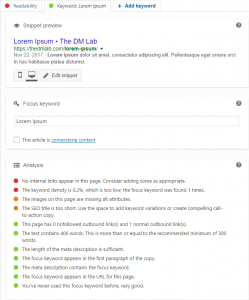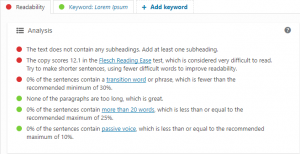How to optimise your blogs using the Yoast SEO Plugin
We absolutely swear by the Yoast SEO Plugin for blogs. If you don’t already use it, get it in your life now! There’s a link at the bottom of this. If you do use it you’ll be reading this hoping to be able to get those coveted green bullets. Are we right? Copywriting is a skill of it’s own. So is optimising a blog. It isn’t often we can CTRL-C and CTRL-V copy that is perfectly optimised. The Yoast SEO Plugin is a Godsend for helping get the most out of blogs. Ascertaining the best keywords from the piece then structuring the blog around this. It isn’t easy but it is fun. We strive for a green light for all points. If you’re familiar with the tool, so have you!
There are many methods and / or tools that can be used to make basic SEO changes on websites. The DM Lab have been using the Yoast SEO Plugin for WordPress. For almost as long as we have been in business! Successfully installing the free or premium version on over 50 websites. This plugin coupled with a few of their others such as local SEO can be a very powerful tool.
Why do we do this?
We add these plugins and do some simple configuration, training our clients to do amends themselves. Leaving the advanced SEO techniques to an agency like ourselves. We also believe that clients will always have a better understanding of their business. Allowing them the ability to promote their brand and making the snippets more engaging. Instead of looking like an overly optimised meta title or meta description (A big no no). Engaging meta date will lead to more clicks and better user experiences. All you have to do is remember the basics. Remember meta data means “data about data.”
The Yoast SEO Plugin helps simplify basic SEO elements.
More advanced SEO still needs all of the planning, research and implementation that requires a specialist.
One thing we come across quite often are clients that will struggle to write content. In fact many obsess about optimisation before even writing it. Because of this obsession it can cause a creativity block. Unless you’re using a copywriter of course. Your passion and drive behind the business should be enough to start putting pen to paper. In this case fingers to a keyboard! From this you will find that you begin generating business or industry specific keywords. In turn these you can begin optimising for.
The easiest (if any part of this is easy) is first write the blog. Focus on a keyword. Bang it out in Word without even thinking about optimisation. Then copy it all into a new post in your website’s back-end. This may seem backward and twice the work but bear with us.
Let’s see if this works.
We’ll try creating a blog post made up of dummy text. Lorem Ipsum. Then we’ll deconstruct it with help from the Yoast SEO Plugin.
You can find that test blog here.
Title and keywords will be Lorem Ipsum. The words were copied from here. Typically the blog should be at least 300 words. This text is currently 404 words so is plenty for this demo. Below is the result.
Not a terrible start. Let’s refine it.
We’ll go from the top down.
Edit the snippet in the Yoast SEO Plugin box to add a unique meta description.
We’ve used the first 3 sentences which include the keyword. We get a green bullet.
No images appear. This is an easy one. Source an image or images relevant to your post. Be aware of image copyrights! We borrowed this clock from Shutterstock. In this example it’s linked to it and we added the caption ‘Tempus Fugit’. See what we did there?! We’ve checked off the outbound link requirement. Outbound is going somewhere other than on your site. One more green bullet.

OK, we’re missing some internal links. This takes some thought normally. However in this case, we’re linking to this blog from that one. There’s our internal link (one that stays within your website). Check!
Now we cross over between Keyword and Readability to turns some reds to green. What is done on one impacts the other. There is no set method to this. Trial and error plus a bit of learning. The dummy text we’ve used is gobbledegook – in Latin and English. For the sake of content, we’ll have a go a restructuring it. Instead of rewriting it. Hopefully it will give some insight as to the methods.
Switch to the Readability tab on the Yoast SEO Plugin box
Unless you are already familiar with the Yoast SEO Plugin, your blog won’t be optimised. In the way that Yoast requires it to be of course. The image below paints a typical picture.
The text does not contain any subheadings. Let’s start with a H1. What’s the blog about? Include the keyword. We’ve chosen the first line of the text and turned it into a sample heading. Include the keyword in the first sentence, perhaps questioning what the blog is about. In this case we’ve copied it – but don’t do this!
We’ve checked off the need for a heading and the keyword is included in the first sentence. 2 green bullets! Bonus! Back to the Readability. Still red and red is bad. Let’s sort it out. We will ignore the Flesch Reading Ease test score for now. This will improve as the blog is refined further. Moving on to the second red, we need to insert another heading.
Tempus Fugit
Let’s say that the image has relevance to the blog (which it absolutely should). This is a dummy test so understand these are tips to apply to real world blogs. The following paragraph, again let’s say, relate to the image. The heading therefore will be Tempus Fugit. In this example it’s a H2 but it all depends on the overall significance to the piece.
An orange bullet. Not bad! There is no need to get all bullets green. Yoast even says this themselves. Don’t spend the rest of your life on one blog trying to get that last bullet green. Some blogs can be optimised easier than others. It’s just how it is.
You’ll see that inadvertently we’ve achieved green bullets. Almost effortlessly in this example but it’s never that easy.
Paragraphs should not exceed 150 words
Include a relevant subheading no more than 300 words apart
Keep sentences below 20 words
Why are you telling me this now?!
Wish you’d told me this at the start! Calm down – with good reason! We write our articles in Word focusing on quality, relevant content. Keeping the keyword in mind and how the post can be linked internally and externally. That’s a lot to consider besides the 3 points above! Structure it as best you can and refine in in the back-end.
When we write blogs or posts, we learn how to minimise the amount of work between the processes. That is creating good content and then optimising it. It’s a little easier for us and it’ll come in time, don’t worry!
Back to the blog
This is a poor example as it won’t score highly in the Flesch Reading Ease test. Mainly because the text is in Latin and if you translate it – it’s nonsense! So we’ll have to let you figure that out on your own. In the meantime, we’ll move on to the second red bullet.
Transition Words
What is a transition word? It’s a long time since our school days and you probably don’t remember either. Here’s a quick refresher. Transition words are 2 sentences that become a single sentence. That link seamlessly together. Sounds simple right? Yes. But remember to keep the sentences at or below 20 words! Here are a few transition words to help make sense of this:
However
For example
Nevertheless
Such as
But
In particular
Thus
To back track on some of the elements you may be asking ‘what about them’? Well, a good subheading to finish with is ‘In conclusion’ or the like. We’ve added this into the blog. Conscious of the number of words in the paragraphs. Nothing changed with regards to bullet colours. It’s just good practise nevertheless keep at it.
Alt Attributes
If you’re not sure what thiese are – Yoast explains here. This addressed by adding a relevant description of the image. Turning that orange bullet green.
Again bear in mind this is a sample post. Your title should be interesting, compelling and include the keyword. Let’s add ‘Latin Dummy Text Test Post’ to the title. It gives a little more away. Such as explaining more what it is about. And there we have it. Green, green, green!

We can write a good post and optimise it. Teachers we are not! Reading this we hope it makes sense and helps you with your blogs. We definitely recommend the Yoast SEO Plugin. Click here for details. Another great resource, also by Yoast is their blog:
10 tips for an awesome and SEO friendly blog post
Hopefully you put all this together to create the best blog posts you’ve ever published. However if you do find this useful, please share it!
Oh, if you were wondering, this blog is optimised exactly as we have explained. Here’s the proof!
Courtesy of the Yoast SEO Plugin…
Thank you for reading! Now go get the Yoast SEO Plugin and write your best blogs ever!



















